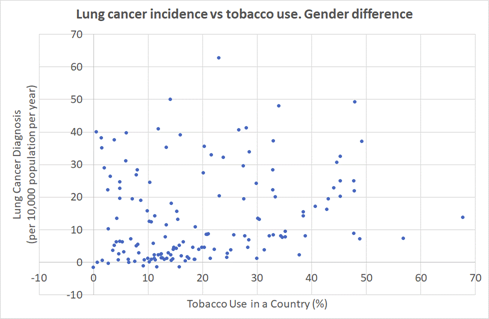Lung cancer, a humorous story.
This began as an investigation into passive smoking but morphed into something else.
Using data from the World Health Organisation, WHO, I plotted lung cancer incidence vs tobacco smoking. Each point is one country. Figure 1.

Fig 1.
The evidence is unequivocal, almost all lung cancer is caused by tobacco smoking.
There’s still a fair bit of scatter in Fig 1. Some countries have a moderate incidence of lung cancer but a high incidence of tobacco use. Other countries have as high incidence of lung cancer but a moderate incidence of tobacco use. Countries with the same incidence of tobacco use can have a lung cancer rate differing by a factor more than twenty. This is not too surprising because different countries have different climatic, social and economic conditions.
Can I reduce the scatter? One way would be to compare tobacco and lung cancer rates between men and women in the same country to reduce the dependence on climatic, social and economic conditions. The difference in lung cancer rate vs the difference in tobacco usage rate between men and women in each country is plotted in Figure 2.

Fig 2.
What the heck. The relationship between lung cancer and tobacco smoking has almost vanished.
To further clarify what is happening, I plotted life expectancy against tobacco usage. Figure 3.

Fig. 3.
There you go. Life expectancy actually increases with increased tobacco usage. This one is more understandable. Lung cancer from tobacco smoking, specifically squamous cell carcinoma, tends to kick in at ages above 50, more at ages above 60. So in countries with a low lifespan, the influence of lung cancer from tobacco becomes less significant. That doesn’t explain all that can be seen in the chart in Figure 3, but some of it.
I noticed when drawing these that countries with low tobacco incidence rates tend to be the poorer countries. Perhaps because tobacco is expensive or transport of goods is difficult, perhaps not. So I plotted lung cancer incidence vs personal income from WHO data. The result is in Figure 4.

Fig 4.
There is a strong correlation between income per capita and lung cancer incidence. As strong a correlation as in Fig. 1 with lung cancer incidence vs tobacco smoking. The evidence is unequivocal, almost all lung cancer is caused by high personal income.
pmsl
Hypotheses anyone?
I have a few wild speculative hypotheses.
- Perhaps only people in rich countries can afford to chain smoke.
- Perhaps the poorer countries never took up tobacco smoking so never got hooked, a historical thing.
- Rich countries spend more time indoors, and wildlife shuns being indoors, so perhaps there’s something deadly in our houses.
- Rich countries spend more time driving, so perhaps there’s something deadly in our cars.
- Rich people shower more so perhaps there’s something about inhaling gases in the shower.
- Hungary is one of the top two countries for both Covid and lung cancer but not tobacco usage, so perhaps the common cold is more prevalent in rich countries and post-viral effects contribute to lung cancer.